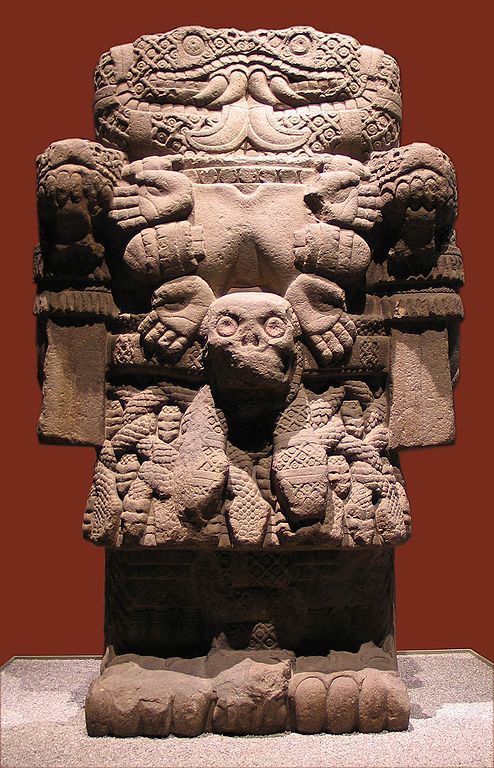The Aztecs
The Aztecs’ rise to power had been recent and swift. Only 400 years earlier, according to their own legends, they had been a nomadic people living far north of the Valley of Mexico in a distinct place called Aztlan. The term Aztec derives from the word Aztlan, and refers to all those living in Central Mexico who came from this mythical homeland, not just to the Mexica of Tenochtitlan.[1]

Eagle-man, c. 1440-69

The arts were practiced with undiminishing vigour under the Aztecs – or ‘Mexica,’ as they called themselves – a group originally of farmers and fishermen who evolved a structured society, migrated down the Valley of Mexico, and in 1325 settled on a marshy island in the Lake Tetzcoco, founding the city of Tenochtitlán (the site of present-day Mexico City). After paying tribute and supplying mercenary soldiers to city-states around the lake, they began in 1427 to expand their own rule and had subjugated most of the peoples of Mesoamerica by 1520 when the Spanish invaders bought the long history of wholly indigenous civilizations to a close. The sheer quantity of work produced in this brief final phase is astonishing. In little more than a century, Tenochtitlán had been developed into the largest and richest city on the American continent, with housing for about a quarter of a million workers and merchants, and spacious palaces and gardens for the hereditary nobility, surrounding a sacred precinct some 500 yards (450 m) across and dominated by twin temple-topped stepped pyramids. To the first Europeans who reached the lake-side, it seemed an enchantment, although even these hardened adventurers were soon appalled by the bloody rites performed in this beautiful setting. Human sacrifice, practiced by most other Mesoamericans, was the central mystery or sacrament in the religion of the Aztecs, the means of preserving cosmic harmony. On dates determined by the astronomical calendar, they sacrificed their own people, tearing out hearts and flaying skin that was sometimes worn by priests – as many statues reveal.[2]

Eagle Warrior, from the House of the Eagles, c. 1400-1521.
To obtain prisoners to be sacrificed to the gods, as well as wealth for themselves, the Aztecs embarked on their campaigns of imperial expansion, the success of which was due to their soldiers’ disciplined willingness to confront death (as the Spanish were to discover). A sensitively modeled youthful face, half hidden by a helmet in the form of an eagle’s head, suggests the unflinching gaze of one of the warriors.
The head is part of the statue of a man with wings on his arms but with a crudely schematized body (perhaps originally covered with a textile garment) found in the House of the Eagles, the assembly place for one of the highest-ranking military orders. Although probably intended as an allegorical image of the sun at dawn, the face seems also to represent an ideal of aristocratic refinement. [3]
Additionally, and perhaps most importantly, the war suit served a symbolic function, since it was believed that in dressing like an eagle or a jaguar, the warrior adopted the power and skill of their assigned animal, thus ensuring a more successful hunt. The symbolism of the war suit was further emphasized by its materiality, since most warriors, except for the nobility, wore suits made of animal skin. The eagle warrior not only acted like an eagle, but also literally resembled one.
Coatlicue, Mexico, Aztec, c. 1500

The colossal statue of Coatlicue, which means ‘she of the serpent skirt,’ goddess of life and death, is the largest and most finely wrought of several similar Aztec figurines. It was preserved intact perhaps because neither the Spaniards nor their locally employed laborers dared to violate a figure of such obvious supernatural power. (When disinterred in 1790 the statue was promptly re-buried and not put on public view until the mid-nineteenth century). Coatlicue is shown decapitated by her jealous children while giving birth to the Aztec national god Huitzlopochtli. The heads of two snakes rise from her neck confronting one another to simulate a face with unwinking reptilian eyes. A skull dangles from a necklace of human hands and hearts about her pendulous breasts and she wears a skirt of entwined snakes. There are serpent fangs at her elbows and her feet have feline claws. Images of terrifying deities of other cultures are docile in comparison. Although completely dehumanized, the statue owes its almost hallucinatory power to the combination of recognizably human elements with naturalistically carved natural forms – the slithering bodies of snakes and their vastly magnified heads.[4]

